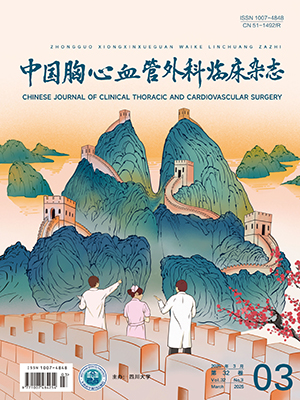| 1. |
Spadaccio C, Benedetto U. Coronary artery bypass grafting (CABG) vs. percutaneous coronary intervention (PCI) in the treatment of multivessel coronary disease: Quo vadis?—A review of the evidences on coronary artery disease. Ann Cardiothorac Surg, 2018, 7(4): 506-515.
|
| 2. |
乐士冠, 肖健, 奚望, 等. 冠状动脉旁路移植术后静脉桥血管再狭窄的机制研究进展. 第二军医大学学报, 2017, 38(5): 639-645.
|
| 3. |
Caliskan E, de Souza DR, Böning A, et al. Saphenous vein grafts in contemporary coronary artery bypass graft surgery. Nat Rev Cardiol, 2020, 17(3): 155-169.
|
| 4. |
Obed D, Fleissner F, Martens A, et al. Total arterial revascularization with radial artery and internal thoracic artery T-grafts is associated with superior long-term survival in patients undergoing coronary artery bypass grafting. Ann Thorac Cardiovasc Surg, 2020, 26(1): 30-39.
|
| 5. |
Guida G, Ward AO, Bruno VD, et al. Saphenous vein graft disease, pathophysiology, prevention, and treatment. A review of the literature. J Card Surg, 2020, 35(6): 1314-1321.
|
| 6. |
Zhang L, Freedman NJ, Brian L, et al. Graft-extrinsic cells predominate in vein graft arterialization. Arterioscler Thromb Vasc Biol, 2004, 24(3): 470-476.
|
| 7. |
Dianati Maleki N, Ehteshami Afshar A, Parikh PB. Management of saphenous vein graft disease in patients with prior coronary artery bypass surgery. Curr Treat Options Cardiovasc Med, 2019, 21(2): 12.
|
| 8. |
Node K, Fujita M, Kitakaze M, et al. Short-term statin therapy improves cardiac function and symptoms in patients with idiopathic dilated cardiomyopathy. Circulation, 2003, 108(7): 839-843.
|
| 9. |
Horwich TB, MacLellan WR, Fonarow GC. Statin therapy is associated with improved survival in ischemic and non-ischemic heart failure. J Am Coll Cardiol, 2004, 43(4): 642-648.
|
| 10. |
Oesterle A, Liao JK. The pleiotropic effects of statins—From coronary artery disease and stroke to atrial fibrillation and ventricular tachyarrhythmia. Curr Vasc Pharmacol, 2019, 17(3): 222-232.
|
| 11. |
Do e Z, Fukumoto Y, Sugimura K, et al. Rho-kinase activation in patients with heart failure. Circ J, 2013, 77(10): 2542-2550.
|
| 12. |
Kang S, Kim K, Noh JY, et al. Simvastatin induces the apoptosis of normal vascular smooth muscle through the disruption of actin integrity via the impairment of RhoA/Rac-1 activity. Thromb Haemost, 2016, 116(3): 496-505.
|
| 13. |
Hwang AR, Han JH, Lim JH, et al. Fluvastatin inhibits AGE-induced cell proliferation and migration via an ERK5-dependent Nrf2 pathway in vascular smooth muscle cells. PLoS One, 2017, 12(5): e0178278.
|
| 14. |
Abdullah S, Jarrar Y, Alhawari H, et al. The influence of endothelial nitric oxide synthase (eNOS) genetic polymorphisms on cholesterol blood levels among type 2 diabetic patients on atorvastatin therapy. Endocr Metab Immune Disord Drug Targets, 2021, 21(2): 352-359.
|
| 15. |
Sanvee GM, Panajatovic MV, Bouitbir J, et al. Mechanisms of insulin resistance by simvastatin in C2C12 myotubes and in mouse skeletal muscle. Biochem Pharmacol, 2019, 164: 23-33.
|
| 16. |
Wang L, Luo JY, Li B, et al. Integrin-YAP/TAZ-JNK cascade mediates atheroprotective effect of unidirectional shear flow. Nature, 2016, 540(7634): 579-582.
|
| 17. |
Buttitta LA, Edgar BA. How size is controlled: From Hippos to Yorkies. Nat Cell Biol, 2007, 9(11): 1225-1227.
|
| 18. |
Pan D. Hippo signaling in organ size control. Genes Dev, 2007, 21(8): 886-897.
|
| 19. |
He J, Bao Q, Yan M, et al. The role of Hippo/YES-associated protein signalling in vascular remodelling associated with cardiovascular disease. Br J Pharmacol, 2018, 175(8): 1354-1361.
|
| 20. |
Grzeszkiewicz TM, Lindner V, Chen N, et al. The angiogenic factor cysteine-rich 61 (CYR61, CCN1) supports vascular smooth muscle cell adhesion and stimulates chemotaxis through integrin alpha(6)beta(1) and cell surface heparan sulfate proteoglycans. Endocrinology, 2002, 143(4): 1441-1450.
|
| 21. |
Ruiter MS, Pesce M. Mechanotransduction in coronary vein graft disease. Front Cardiovasc Med, 2018, 5: 20.
|
| 22. |
Kimura TE, Duggirala A, Smith MC, et al. The Hippo pathway mediates inhibition of vascular smooth muscle cell proliferation by cAMP. J Mol Cell Cardiol, 2016, 90: 1-10.
|




